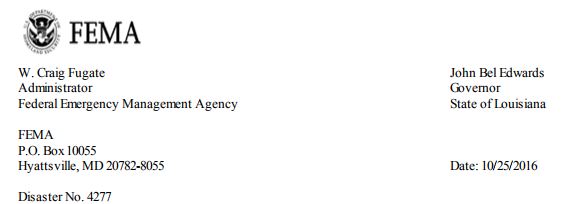By Murray Wennerlund published 11-16-2024 updated 11-16-2024
|
|
|

By Murray Wennerlund published 4-15-2018 updated 10-31-2022

By Murray Wennerlund published 4-15-2018 updated 10-31-2022
The Individuals and Households Program covers many different types of grants as a form of an advance on your total FEMA / Insurance Claim. To make it simple, think of your Flood Insurance as a Group of companies that work with federal dollars and they call themselves “NFIP” or National Flood Insurance Program. Here's a copy of a letter sent to a homeowner offering money to make minor repairs so to get back in the home. This type of offer is based on homeowners with flood insurance that can be deducted as DOB at a later time.
If you are facing a large “Homeowner Responsibility” number this may be what they are looking at.
This is not associated with the SBA loans.
=== START LETTER FROM FEMA ===
The Federal Emergency Management Agency (FEMA) has carefully reviewed your application for disaster assistance. This letter explains the assistance you are eligible to receive from FEMA's Individuals and Households Program.
ASSISTANCE APPROVED The U.S. Department of the Treasury will either mail you a check, or deposit the funds into your bank account based on the method you chose when you applied with FEMA.
You are eligible for a total of $32,129.00:
Eligible - Home repairs w/ flood insurance requirement (EHRZ)
You have been APPROVED for $32,129.00 for Home Repair Assistance, which is provided to help make essential repairs that will allow you to occupy your home. It is not intended to repair all home damage.
The amount provided to you is based on the damage caused by the disaster and the estimated cost of repairs. Your home is located in a Special Flood Hazard Area. By accepting this assistance, you have a requirement to maintain flood insurance on the damaged home as long as the address exists and you own the property. If you do not maintain flood insurance, you will not be eligible for some FEMA assistance if another flood disaster damages your home.
If you do not accept the requirement to maintain flood insurance, you must return all disaster assistance money for the National Flood Insurance Program insurable real and/or personal property within 30 days from the date of this letter. For more information about this requirement or to learn where to obtain flood insurance, call 800-638-6620 or visit www.FloodSmart.gov. Your home is located in a Special Flood Hazard Area designated by the National Flood Insurance Program (NFIP). If you accept money from FEMA for NFIP-insurable real and/or personal property, you must obtain and maintain flood insurance. For more information about this requirement or to learn where to obtain flood insurance call 1-800-638-6620 (National Flood Insurance Program).
FEMA is limited in the types and amount of assistance it can provide. FEMA assistance may not cover all of your losses caused by the disaster.
By law, FEMA must ensure that no person receives duplicate assistance for any part of a loss for which the individual has received financial assistance under any other program, from insurance, or from any other source. If you have insurance coverage for your losses caused by the disaster, you may only be eligible for certain types of FEMA assistance. Please make sure you provide FEMA with your updated insurance settlement information. If you have not already done so, you should contact your insurance provider to file a claim. If you have insurance coverage for a loss for which you receive FEMA assistance, you may be required by law to return the FEMA assistance you received, so it is important to provide accurate insurance information.
FEMA is required by law to conduct routine audits of disaster assistance provided and to recover any assistance that was awarded in error, the applicant spent the funds inappropriately, or the applicant obtained the funds through fraudulent means. You should keep copies of all documents submitted to and received from FEMA, and any receipts showing how you used your FEMA assistance. In rare instances, there may be a requirement for you to return some or all of the assistance provided.
=== END LETTER FROM FEMA ===
The delivery sequence specifies the following order in which a program should provide assistance and the other resources that must be considered before doing so:
While HUD CDBG grants are not specifically listed in the regulation, guidance since issued by FEMA considers these grants to be “other Federal … funds” that follow SBA disaster assistance loans in the sequence of disaster benefits(3). SBA's Standard Operating procedure 50 30 6 reiterates FEMA's delivery sequence, and specifically states that CDBG funds are lower than SBA disaster loans in the sequence of delivery.
FEMA regulations state that duplicate benefits can occur when any agency provides assistance for a loss, which is the primary responsibility of another agency that is higher in the delivery sequence. Each agency should, in turn, offer and be responsible for delivering its program(s) without concern about duplication with a program later in the sequence. Further, agency programs listed later in the sequence are responsible for preventing duplication from programs listed earlier, and thus are responsible for rectifying any duplication and recovering payments from the disaster relief recipient."
(From the link provided below)